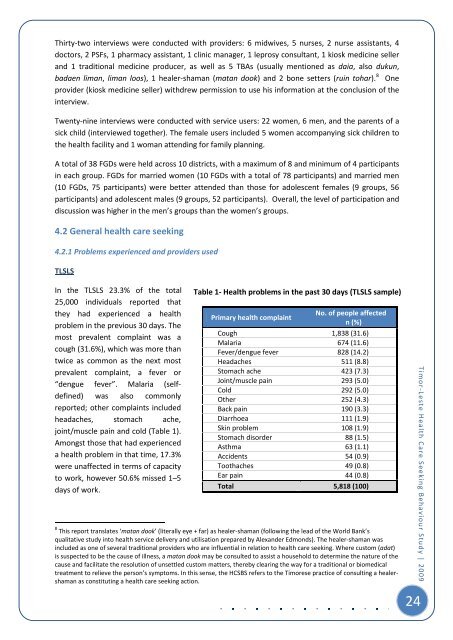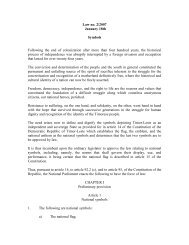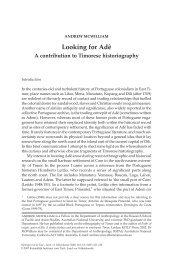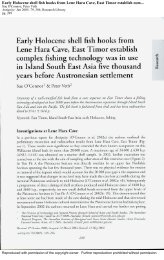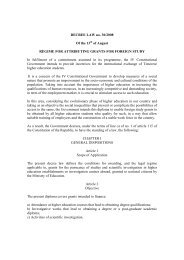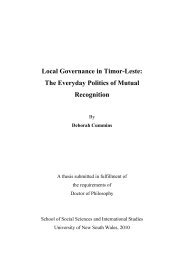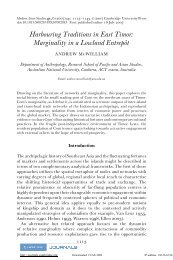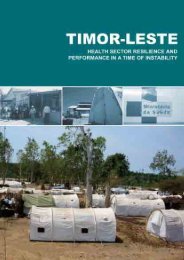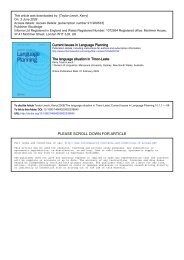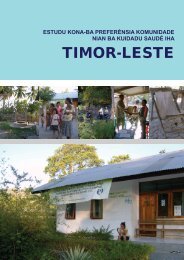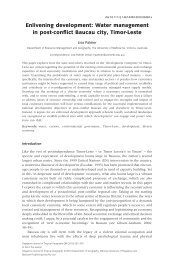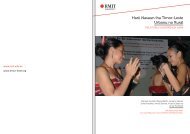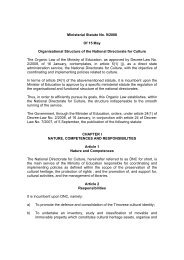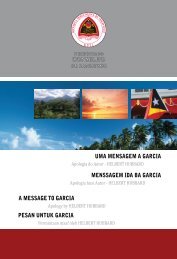Timor-Leste Health Care Seeking Behaviour Study - Secretaria de ...
Timor-Leste Health Care Seeking Behaviour Study - Secretaria de ...
Timor-Leste Health Care Seeking Behaviour Study - Secretaria de ...
- No tags were found...
You also want an ePaper? Increase the reach of your titles
YUMPU automatically turns print PDFs into web optimized ePapers that Google loves.
Thirty-two interviews were conducted with provi<strong>de</strong>rs: 6 midwives, 5 nurses, 2 nurse assistants, 4doctors, 2 PSFs, 1 pharmacy assistant, 1 clinic manager, 1 leprosy consultant, 1 kiosk medicine sellerand 1 traditional medicine producer, as well as 5 TBAs (usually mentioned as daia, also dukun,badaen liman, liman loos), 1 healer-shaman (matan dook) and 2 bone setters (ruin tohar). 8 Oneprovi<strong>de</strong>r (kiosk medicine seller) withdrew permission to use his information at the conclusion of theinterview.Twenty-nine interviews were conducted with service users: 22 women, 6 men, and the parents of asick child (interviewed together). The female users inclu<strong>de</strong>d 5 women accompanying sick children tothe health facility and 1 woman attending for family planning.A total of 38 FGDs were held across 10 districts, with a maximum of 8 and minimum of 4 participantsin each group. FGDs for married women (10 FGDs with a total of 78 participants) and married men(10 FGDs, 75 participants) were better atten<strong>de</strong>d than those for adolescent females (9 groups, 56participants) and adolescent males (9 groups, 52 participants). Overall, the level of participation anddiscussion was higher in the men’s groups than the women’s groups.4.2 General health care seeking4.2.1 Problems experienced and provi<strong>de</strong>rs usedTLSLSIn the TLSLS 23.3% of the total25,000 individuals reported thatthey had experienced a healthproblem in the previous 30 days. Themost prevalent complaint was acough (31.6%), which was more thantwice as common as the next mostprevalent complaint, a fever or“<strong>de</strong>ngue fever”. Malaria (self<strong>de</strong>fined)was also commonlyreported; other complaints inclu<strong>de</strong>dheadaches, stomach ache,joint/muscle pain and cold (Table 1).Amongst those that had experienceda health problem in that time, 17.3%were unaffected in terms of capacityto work, however 50.6% missed 1–5days of work.Table 1- <strong>Health</strong> problems in the past 30 days (TLSLS sample)Primary health complaintNo. of people affectedn (%)Cough 1,838 (31.6)Malaria 674 (11.6)Fever/<strong>de</strong>ngue fever 828 (14.2)Headaches 511 (8.8)Stomach ache 423 (7.3)Joint/muscle pain 293 (5.0)Cold 292 (5.0)Other 252 (4.3)Back pain 190 (3.3)Diarrhoea 111 (1.9)Skin problem 108 (1.9)Stomach disor<strong>de</strong>r 88 (1.5)Asthma 63 (1.1)Acci<strong>de</strong>nts 54 (0.9)Toothaches 49 (0.8)Ear pain 44 (0.8)Total 5,818 (100)8 This report translates ‘matan dook’ (literally eye + far) as healer-shaman (following the lead of the World Bank’squalitative study into health service <strong>de</strong>livery and utilisation prepared by Alexan<strong>de</strong>r Edmonds). The healer-shaman wasinclu<strong>de</strong>d as one of several traditional provi<strong>de</strong>rs who are influential in relation to health care seeking. Where custom (adat)is suspected to be the cause of illness, a matan dook may be consulted to assist a household to <strong>de</strong>termine the nature of thecause and facilitate the resolution of unsettled custom matters, thereby clearing the way for a traditional or biomedicaltreatment to relieve the person’s symptoms. In this sense, the HCSBS refers to the <strong>Timor</strong>ese practice of consulting a healershamanas constituting a health care seeking action.24<strong>Timor</strong>-<strong>Leste</strong> <strong>Health</strong> <strong>Care</strong> <strong>Seeking</strong> <strong>Behaviour</strong> <strong>Study</strong> | 2009


